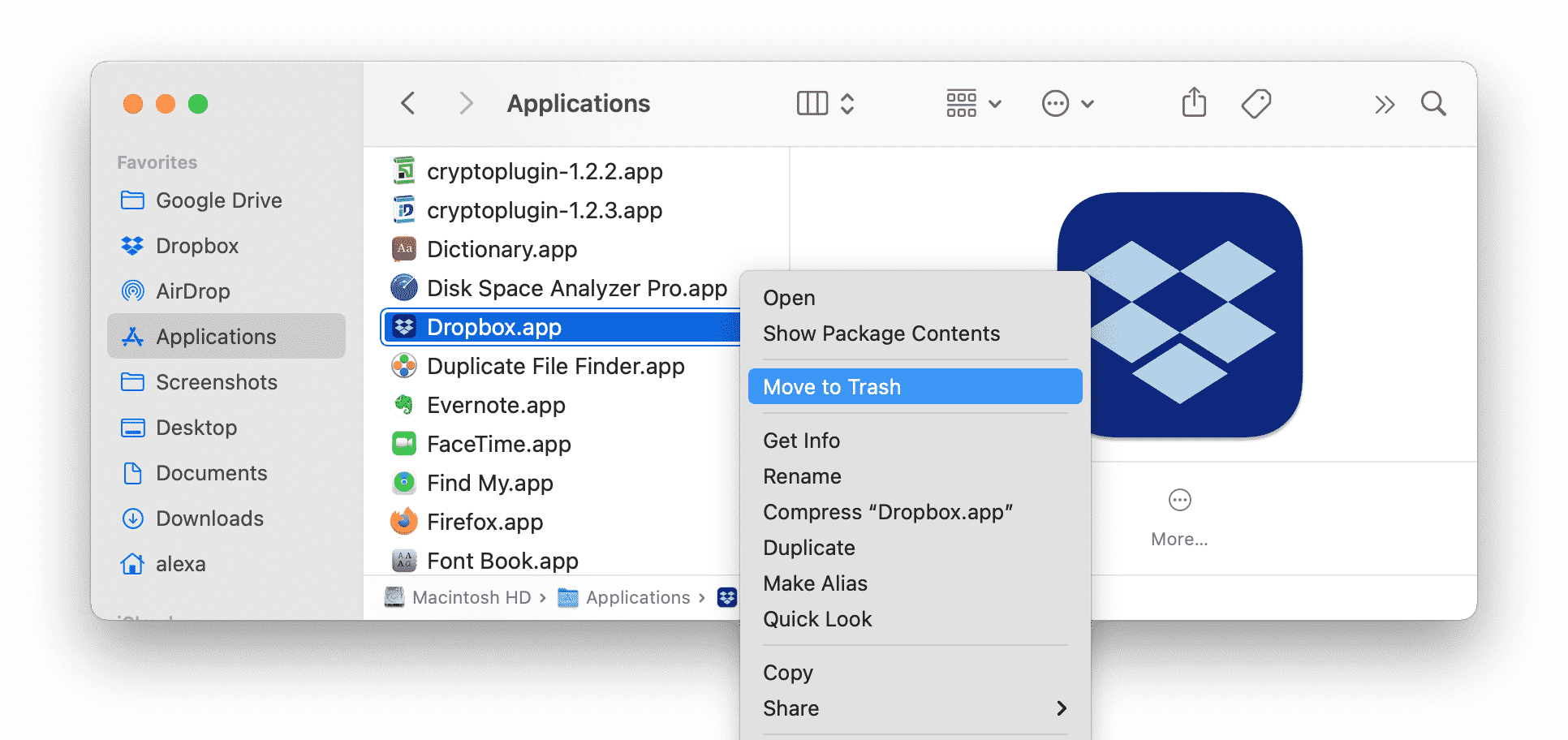- How To Use Dropbox On Mac
- How To Use Dropbox On Macbook
- Download Dropbox For Mac
- How To Share Files Using Dropbox On Mac
- Using Dropbox On Mac
Automatically download files from one computer to another
There's a two-step process to automatically migrate files from one computer to another. First, you'll download and install the Dropbox desktop app on both computers. Next, you'll use the app to migrate files between computers.
However, Dropbox works great on Mac and Windows devices as well as on mobile devices (including iOS and Android devices). It may take setting up, but you won’t find it hard to sync a file from a. Mac Subscription 107 people found this helpful After you've set up Dropbox on your computer, you can back up any file, (including your Quicken backups), by placing it in the Dropbox folder. All files in your Dropbox folder are automatically backed up to Dropbox every time a file is added or changed. To store, retrieve and manage your files, you can use a Dropbox application that is compatible with Mac, Windows and Linux systems and can be downloaded and used on any smartphone. Reasons to use Dropbox. Using Dropbox can be very helpful for businesses. Here we have listed 7 main advantages of this service. Why is the new version of Dropbox using so much memory on my mac? Currently Dropbox is using 258.9 MB of memory. I don't use Smart Sync. I don't have more than 300,000 files synced to my mac. I don't use the desktop app or want to use it, I use the standard Dropbox app that lives in the Menubar. I don't use 'Selective Sync' Dropbox version: 79.
Before you begin
- If you have a large number of files, consider prioritizing them so the files you use every day migrate before archived files
- Also consider migrating your data in batches, or doing the migration overnight or on a weekend
- Be sure that the computer you're migrating files to has enough hard drive space (by default, the Dropbox desktop app keeps a copy of files on your computer's hard drive)
- Check the amount of space in your Dropbox account, and consider upgrading if necessary (by default, Basic accounts have 2 GB of space, while Plus and Family accounts have 2 TB)
- If you want to delete files from your old computer, or if you want to wipe the hard drive entirely, be sure to first sign out of Dropbox on that computer and uninstall the Dropbox desktop app (this will ensure synced files aren't deleted from Dropbox or from your new computer)
Download and install Dropbox on both computers
- Visit the Dropbox install page and download the latest version of the desktop app.
- Note: you don't need to re-install the desktop app if you already have it on one or both of your computers
- Once the installation finishes, sign in to your Dropbox account or sign up for a new one.
- After signing in, click Open my Dropbox.
Notes:

Open your Dropbox folder. To find it, click the Finder icon in the Dock (a smiling blue and gray Mac logo), then click Dropbox in the left panel. This folder is like your Dropbox “home,” meaning that anything you add to this folder will be synced to your Dropbox account so you can access them from anywhere.
- Be sure to sign in to Dropbox using the same account on both computers (this ensures that the files in your Dropbox account on one computer migrate to the other computer)
- If the install is successful, you'll see a Dropbox folder on the hard drive of both computers, and the Dropbox icon will appear in your taskbar (Windows) or menu bar (Mac).

Migrate files from one computer to another
- On the computer you're migrating from, open File Explorer (Windows) or Finder (Mac) and navigate to any files or folders that you want to migrate. Drag-and-drop these files or folders to the Dropbox folder on your hard drive.
- As long as the computer you're migrating from is connected to the Internet, these files and folders will then upload to your Dropbox account in the cloud.
- These files and folders will also sync to your new computer, provided both of the following are true:
- The computer you're migrating to is connected to the Internet
- You're signed in to the Dropbox desktop app with the same Dropbox account on both computers
The migration is complete when a green circle with a checkmark appears beside the files and folders in the Dropbox folder on your computer. The Dropbox icon in your taskbar (Windows) or menu bar (Mac) will also say Up to date. You should then see the files and folders on both computers.
During and after migration
- The amount of time it takes for the migration to complete depends on the number of files you're migrating, and on the speed of your internet connection (you can control bandwidth as needed)
- Don't sign out, change settings, or turn off either computer during the migration process (the desktop app can only sync when you're signed in)
- If you lose Internet access during the migration, Dropbox will simply pause syncing, and resume once you're online again
- You can check the sync status at any time using the desktop application
- If you want to delete files from a computer, or if you want to wipe the hard drive entirely, be sure to sign out of Dropbox on that computer and uninstall the Dropbox desktop app (this will ensure synced files aren't deleted from Dropbox)
Copy files manually
The other way to migrate files is to copy them manually from a portable storage device (like an external hard drive) to the Dropbox folder on your computer. The Dropbox desktop app will then scan the files, and see that they're the same files in your Dropbox account.
On your old computer
- Update the Dropbox desktop application to the latest version.
- Wait until syncing has finished, as indicated by the green circle with the checkmark on the Dropbox icon in your menu bar.
- Once syncing has completed, copy the contents of your Dropbox folder to your portable drive (such as a USB drive or external hard drive).
On your new computer

How To Use Dropbox On Mac
- Install the latest version of the Dropbox desktop application and sign in to your account when prompted.
- The application will create a Dropbox folder and begin downloading files from your account. Stop the download immediately by clicking the Dropbox icon in your taskbar (Windows) or menu bar (Mac), and selecting Pause Syncing from the menu.
- Copy the files from your portable drive into the Dropbox folder.
- Resume syncing by clicking the Dropbox icon in the taskbar (Windows) or menu bar (Mac), and selecting Resume Syncing from the menu.
How To Use Dropbox On Macbook
Default location for the Dropbox folder
Note that the default location for the Dropbox folder is different for each operating system:
- Linux: /home/yourUserName/Dropbox (such as /home/name/Dropbox).
- Mac: /Users/yourUserName/Dropbox (such as /Users/name/Dropbox).
- Windows: %HOMEPATH%Dropbox (such as C:UsersnameMy DocumentsDropbox).

Once you've completed these steps, the Dropbox desktop app will begin scanning the files in your Dropbox folder. If all of these files are the same as the files in your account online, scanning will finish. However if, in the middle of this process, a file has changed in your account (for example, someone else has updated a file in a shared folder), Dropbox will generate a conflicted copy so that both versions of the file are preserved.
Download Dropbox For Mac
Learn more
How To Share Files Using Dropbox On Mac

Using Dropbox On Mac
- By default, Dropbox will try to download all of the folders in your account. If there are folders you don't want taking up space on your computer, you can use selective sync to store them only in the cloud. However, you may need to wait until Dropbox has finished its initial sync of your files before the selective sync option becomes available.
- If you're going to copy files manually, you may want to temporarily leave shared folders. You can then copy your non-shared files to the Dropbox folder, and then re-add the shared folders and let them download to your computer. This will prevent Dropbox from generating conflicted copies of files if other people have changed them, as described above.
